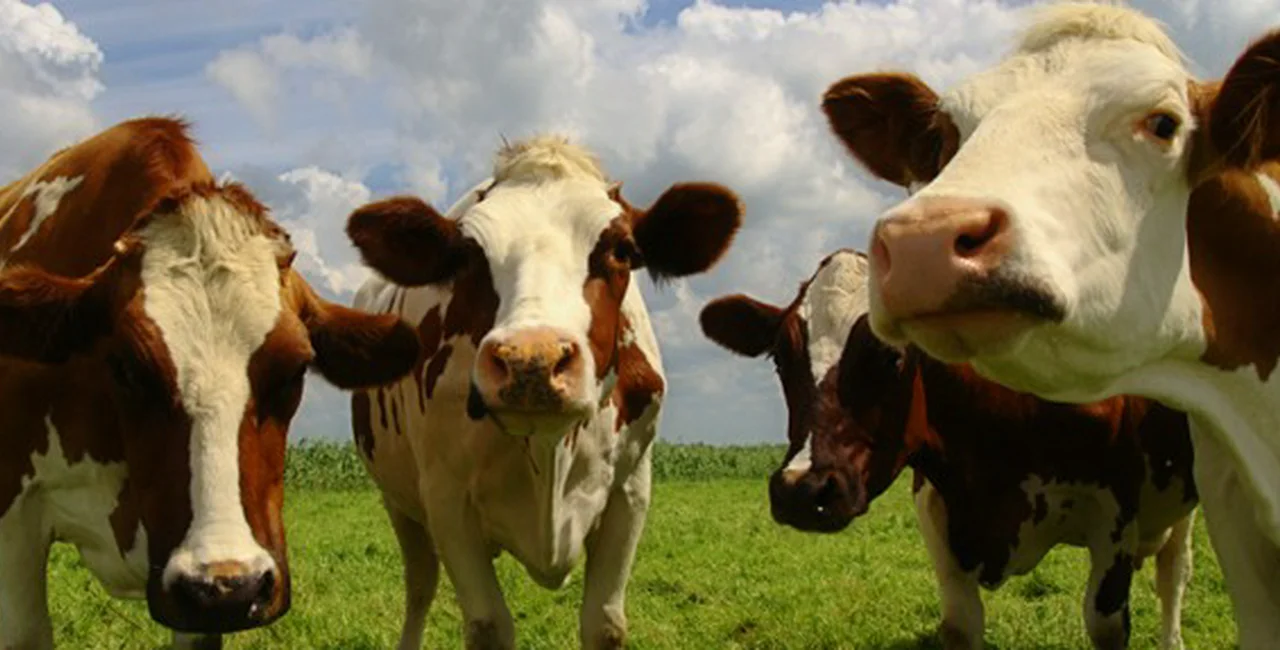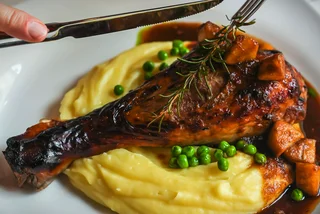I have to chuckle when I recall a story from my husband´s early days in Prague. He´d ordered his lunch in a restaurant, but when he asked for a glass of cold milk to go with it, the waitress was taken aback, and then sternly informed him “This isn´t a milk bar” (“tohle není mléčný bar.”) The point wasn´t that there was no milk in the kitchen; I´m sure they had plenty. But it´s just not done – especially if you´re a grown man. So if you´re going to indulge this bizarre whim, you´d better go to an establishment designated for milk consumption.
In contrast, when I lived in Rhode Island, not only was cold milk and chocolate milk available everywhere, there was even a third option: coffee milk. This is the official state beverage. In my other homeland, Denmark, kids and adults drink cold creamy buttermilk all the time. So you just never know.
What you really don´t know when you first come to the Czech Republic is: what´s what? This printable list of items found in your dairy section is going to set you straight. And if you order a milkshake in a restaurant, be warned that your “shake” or ovocny cocktail will not be thick, like it is in the states, and it might not even be cold. Czechs like their milk at cow temperature.
Milk = Mléko
Regardless the brand, color coding indicates fat content.
- Green packaging is low-fat with .5% (odstředěné, odtučněné, or nízkotučné)
- Blue is skim 1.5% (polotučné = “half fat”)
- Red is whole milk 3-3.5% (plnotučné = “full fat”)

- There´s a high fat milk called svačinové mléko, or “snack milk” with up to 4% fat.
- The percentage if fat is given on the container where it says Obsah tuku. Obsah means containing and tuk is fat, which turns to tučné when used as an adjective.
- Other words you may see in the dairy aisle: trvanlivé (long-lasting), bio (organic), selské (farm) and horské (alpine)
- Dried milk powder (the brand Laktino, for example) is called sušené mléko and is also packaged green, blue, and red according to fat content.
- In the US and many parts of Europe, low-fat dairy is everywhere – low-fat milk, cheese, yogurt and even ice cream. These products are harder to find in the Czech Republic. As of this writing, it is impossible to find fresh low-fat milk in the refrigerated dairy section. You have to buy the long life kind – UHT, Ultra High Temperature, which is stored in another aisle. In Ultra High Temperature processing, milk is heated to 275 F (135 C) for one or two seconds. This makes it able to sit on a shelf for up half a year. It does result in a slightly cooked flavor, which is why it’s unpopular in the US, but it’s the price to pay to watch your waistline, at least until there is more demand for it. Read up on UHT here.
- In America, dairy farmers up their production 20% by injecting their cows with Bovine growth hormone. Only products specially labeled “NO rBGH” are free from the hormone – which has been linked to several types of cancer. Here in the EU, we don´t have to worry about that.
Cream = Smetana
- Smetana means cream. Šlehat means “to whip” so šlehačka is whipped cream.
- The richest of the creams, coded red, has 40% fat.
- Cream in blue packaging, labeled na šlehání, is suitable for whipping. It should have a fat content of around 30%.
- The lighter creams, often packaged in yellow, have 12% and can´t be whipped.
- If you´re using cream for cooking, buy Smetana na vaření.

Sour Cream = Zakysaná smetana
- Sour = kyselý or zakysaný
- Few stores carry light sour cream with 8% fat, but most will have the 11% (smooth=jemná) and the 15% (thick=hustá).
- Green containers typically have less fat, blue containers more.


Yeast = Droždí
- No, it isn´t dairy, but if you´re looking for fresh yeast in blocks, this is where you´ll find it – tucked between cream and eggs or in that general area.
Butter = Máslo and Margarine = Margarín
- Butter is pretty obvious. Check the fat content, it varies.
- You won´t find salted butter, except in specialty shops.
- Margarine is margarine but also referred to as rostlinný tuk or “plant fat”. Brands include Hera, Rama and Perla.
- If the words na pečení are written, the product is intended for baking.
- Note for bakers: rostlinný tuk is ‘Shortening” (similar to CRISCO)

Flavored butter alternatives
- Czechs often spread “cream cheese” on bread. There are many kinds, and they are available in flavors like chive (pažitka), ham (šunka), herbs (s bylinkami) and plain (přírodní). Brands include Lučina and Gervais.
- Pomazánkové máslo has always been considered a butter product in the Czech Republic, but new EU regulations forbid the word ‘butter’ on the package – because butter must have a fat content of at least 80%, and pomazánka has only 30-40%, plus some dried milk, starch and water.

Buttermilk = Podmáslí
- We call it buttermilk, Czechs call it “sub butter”. It is the liquid that seeps out when milk is churned in to butter.
- The fat content is the same as low fat milk (5%) but fermentation makes it much thicker.
- Buttermilk is rich in calcium and has twice the lecithin as whole milk.
Kefír
- Kefír is something you´ll find in every shop in Prague, but where I´ve lived, you´d need to visit a Middle Eastern shop or a health food store. Kefírové mléko is a cultured milk product, like yogurt, but with even more culture and more benefits. “Cultured” means they contain certain beneficial bacteria – or pro-biotic flora – which help with digestion and keep yeast growth in check (as can occur when taking antibiotics). But whereas yogurt products contain only one such bacteria (bi-fidus), kefír contains three or four different strains of bacteria, and it doesn´t just contain them, it colonizes your intestinal tract with them. Learn more at http://www.kefir.net/kefiryogurt.htm
Yogurt = Jogurt
- Yogurts are pretty self-explanatory, thanks to the pictures.
- velké kousky = Big chunks.
- vláknina = fibre, or cereal added.
- smetana = cream, so smetanový = creamy. Sometimes you see the word krém.
- Low-fat yogurt is harder to come by, and non-fat is nonexistent. Bigger stores, like Tesco, will carry tiny containers of reduced fat yogurt – nízkotučný – but so far, only in plain or bílý. The fruit flavored yogurts that are considered diet are instead sweetened artificially and have other thickeners.
- Fat-wise, most yogurts are in the 3% range.
- The fattiest of yogurts (and practically a dessert) is the Greek style, coming in at 10%.
- If you´d like to try something traditional that Czech kids grew up on, look for small glass containers, with metal lids. These yogurts are plain on the top, fruit at the bottom and should be stirred up.
- Drink yogurts (jogurtový nápoj) are popular, and come in flavors like cherry (višně), kiwi-strawberry (kiwi – jahoda) and even apple-mint (jablka – máta).
- Milk that isn´t yogurt but has acidophilus added is called acidofilní mléko.
Tvaroh
- In every dairy section you will see tvaroh. What is this? It is a curd product similar to quark (though it´s not the same, and larger stores will actually carry quark – and call it čerstvý sýr), and cottage cheese (which also exists here, and is called “Cottage”).It is made by warming soured milk causing denaturation, then straining.
- Tvaroh is a well-loved and common ingredient in Czech pastries like the koláč or dishes like žemlovka. Czechs crumble it into crepes, and onto fruit dumplings and even make into a deliciously tart ice cream. Try brands like Míša or Kuba to taste this refreshing alternative.
- Note to bakers: Tvaroh is NOT “Cream Cheese” as we know it in the US – something smeared onto bagels or turned into cheesecake and frosting. Tvaroh is more crumbly and will result in a dryer, harder cake. That´s why “cheese cake” from a Czech menu, even though it´s made with “cream cheese”, is completely different from a NY cheesecake.
- Tvaroh has less whey than say, cottage cheese (which is just curded whey) and that´s what makes it more solid.
- This may be an old wives tale, but putting cold tvaroh into your bra helps combat mastitis.

Pribináček / Bobík / Lipánek
- This is another completely local (as far as I know) product which is described as cream custard. Brand names like Pribináček, Bobík and Lipánek
- This decadent treat can even be used as a quick frosting on cupcakes.
- Some of these are released in limited edition flavors for Christmas and summer.
More desserts
- Mléčná rýže = Rice milk custard
- Pudink = Pudding
Non-refrigerated dairy products
On a non-refrigerated shelf you should find soy milk and creamers:

Next: I´ll leave the topic of cheese for a future article. There are tastier alternatives to the bland Eidam you see everywhere, but you have to know where to look.












 Reading time: 7 minutes
Reading time: 7 minutes 




















